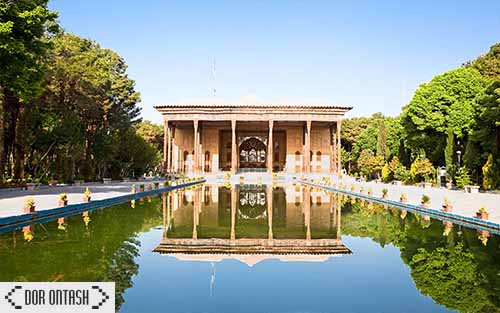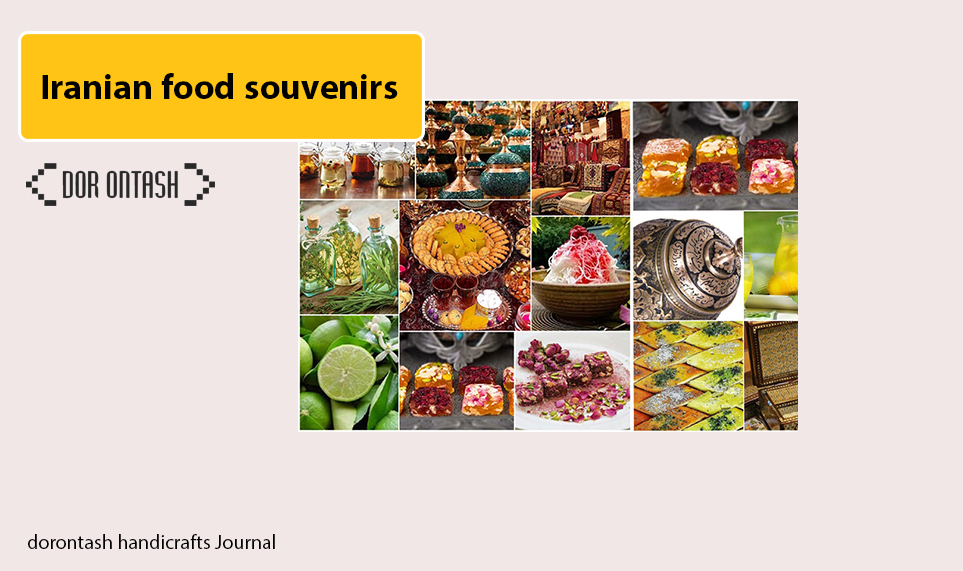The beautiful Chehel sotoon Palace in Isfahan is one of the unique buildings of Iran. Any Iranian who is curious about national identity should not miss seeing the historical monument of Forty Pillars. The Palace of Forty Pillars is a long-standing relic of the Safavid rule in Iran, which fascinates tourists and people interested in Iranian tourism with its amazing and authentic architecture. The ambitious and magnificent paintings of Chehel 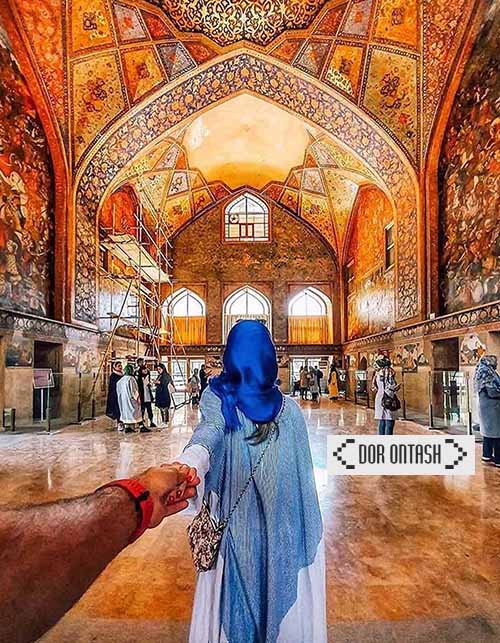 sotoon palacehistorical work are only one of its attractions..
sotoon palacehistorical work are only one of its attractions..
Historical background of Chehel sotoon, a building belonging to the Safavid era
The construction of Chehel sotoon Palace dates back to the era of Shah Abbas the Great. When Isfahan became the capital of Iran, different and huge plans were implemented in this historical city. The construction of a street called Chaharbagh and the gardens around it was one of these plans. Chehel sotoon garden was one of the most important gardens and in fact, it connected other gardens and connected this street to Naqshjehan Square.
During the period of Shah Abbas the Great, by his order, the Kholafrangi mansion or booth was built for foreign and domestic guests. This kiosk was the primary core of the palace.
When Shah Abbas II came to power, this simple pavilion was developed and numerous halls such as the 18-pillar hall, mirrors, luxurious and large rooms were added to it. The new building was decorated with the help of various Iranian arts, such as mirror work, painting, tile work and moqrans work, and became the owner of the title of the most blessed building in the world. A beautiful pond was built in front of the building and doubled the beauty of the palace. The construction of the Forty Seton Palace was completed in 1057 A.H. and it was opened in the presence of foreign and domestic guests and the king.
 The architecture of the Chehel sotoon
The architecture of the Chehel sotoon
This palace has 20 columns and it seems that it is known as forty columns because of the reflection of the columns in the water. If you travel to the city of Isfahan to visit Chehl Seton Palace, a large porch with a length of 38 meters and a width of 17 meters will attract your attention. This porch on the eastern side of the palace has forty columns and has 18 wooden columns with a height of 14 meters made of plantain and pine wood. The top of each column is decorated with inlay work. The four middle pillars are placed on four beautifully carved stone lions. Stone taps are fountains that direct water into the marble pool between these four columns. The roof of the porch is very spectacular and amazing. The material of the ceiling is wood and it is artistically decorated with Chinese knots, paintings and mirrors. There are two columns at the end of the porch with a height of 12 meters, overlooking the Hall of Mirrors. In this part of the building, you will see mosaics and large mirrors.
Ashraf Hall is one of the most important parts of the Chehel sotoon
Ashraf Hall or the main hall with beautiful paintings of the Safavid period is very spectacular and amazing. In the western, southern and northern sides of Ashraf Hall, there are inlaid windows. These windows overlook the pond in front of the building and the garden space and are a place for light to pass into the hall. In the Ashraf hall, six oil paintings can be seen, which remind of the banquet of Shah Abbas, the battle of Chaldaran, Shah Tahmasb and the reception of the Shah of India, the war of Nader Shah with India, the war of Shah Ismail with Shibak Uzbek and the reception of Shah Abbas with Wali Muhammad Khan. They show the painting art of Isfahan.
Along with these amazing paintings, there are also pictures of the celebrations of kings and foreign ambassadors. Three domes with gold decorations and amazing paintings have adorned this hall.
Although the Forty Pillar Palace burned down during the reign of Sultan Hossein Safavid, it was rebuilt once again. During the Qajar era, it suffered serious damage, but it survived and after many years, it is still an ancient and magnificent work in Isfahan, which many tourists and Iranian travelers come to see in Isfahan to see the masterpiece of Iranian art up close.
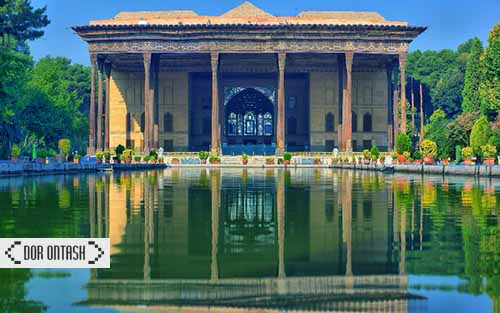 Chehel sotoon Palace title
Chehel sotoon Palace title
The main porch of Chehelston Palace is supported by twenty columns. Many researchers believe that the name of the palace is a reflection of the twenty pillars on the beautiful and large swimming pool of the mansion. Of course, the role of the number 40 in Persian literature
Paintings of Chehel sotoon Palace
The central hall of the palace, which was dedicated to foreign guests and personalities from other countries, contains paintings that describe the historical events of different periods. This magnificent hall is based on a carved dome and is considered one of the artistic masterpieces of that era with its colorful lattices and golden and transparent designs.
It has (this number indicates multiplicity) is also perhaps another reason for naming Chehelstan.
The paintings in the central hall of the palace, some of which were painted in the Qajar era, describe the reception of Shah Abbas I and II and Shah Tahmasb from the princes of Turkestan and Humayun of India, as well as the war of Shah Ismail I with the Uzbeks. Two other pictures, one facing the entrance of the hall and the other in front of it, show the Battle of Chaldaran during the reign of Shah Ismail I and the Battle of Karnal during the reign of Nader Shah Afshar.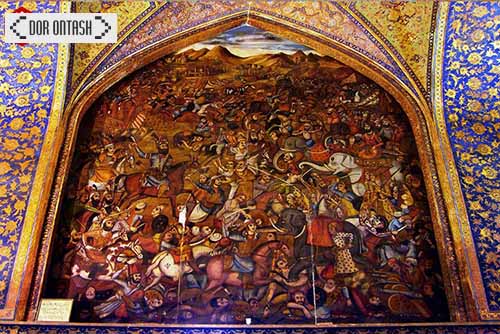
The best time to visit Chehel sotoon Palace
Spring and especially the month of May is the best time to visit Chehelston Palace; Because in addition to the softness of the air, the surrounding garden has a special freshness. Of course, this place is one of the most popular destinations in summer evenings due to the coolness of the air. If you plan to take photos, you can take good photos from 9 to 11 o’clock due to the placement of the sun in front of the palace. Also, at night, Chehelston takes on a different effect with lighting.